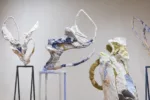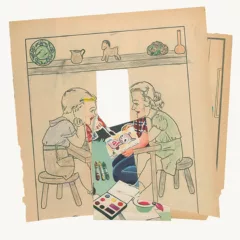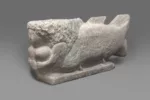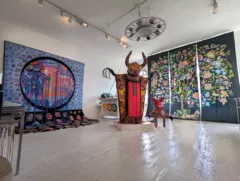Spring has filled the Meltem Birey Gallery in the form of Jerry Mischak’s brightly colored, playful sculptures. Imaginary Solutions, which runs through May 3, uses a combination of consumer materials and urban debris, including small pieces of electronics.
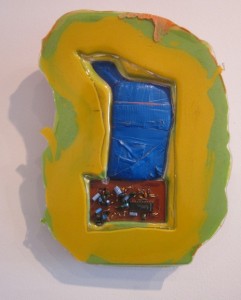
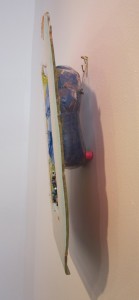
At first look, Mischak’s sculptures seem to be clustering objects together and protecting them with layers of tape or plastic. At the opening, Mischak explained that the clear plastic covering on his small sculptures (all of which are called vacu-form ‘untitled’) was a protective membrane. All of his small sculptures are vacu-formed with clear plastic. As he continued with the series, he decided to flip some of the sculptures around in order to deny the objects the bubble-pack protection.
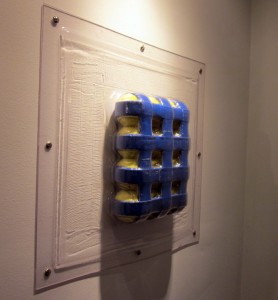
Mischak’s pieces are animated and his latest small sculptures work visually on either side. The first small sculptures he made are covered in vacu-form plastic and have a rectangular outer edge – similar to the packaged products you would buy from a store. These first few pieces established the groundwork for the series.
As the series developed, the outer edge took on a freer form. Some of the pieces seem to be melting and flowing like lava. Others have edges that suddenly jut out and fall in, giving the pieces a syncopated rhythm.
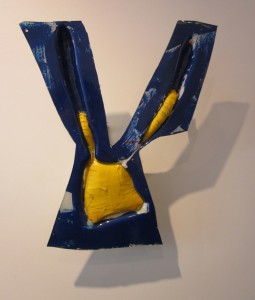
The Providence- and New York-based sculptor, who teaches at the Rhode Island School of Design, has figured out an innovative way of using tape – a material that has been very popular lately. In some cases it is not even recognizable as tape. In some pieces, the tape is layered so thickly that the gooey edges become an object. Through experimentation, the focus moves away from telling viewers what the material is and on to the textures, forms, and colors that material can produce.
During the opening, Mischak explained that he has many influences, but some of the largest influences on his work were Franz West and Robert Rauschenberg. Although Mischak’s pieces are not collages, they address Rauschenberg’s collages by clustering together objects and materials from various places and using them to create colorful, abstract compositions. Other similarities include the bright palette, experimentation with mixed media, animated forms, and a sense of humor.
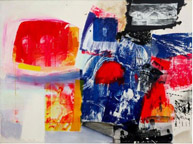
The bright colors fill the room, but the majority of the pieces are small enough not to overpower the gallery. The works are spread far enough apart that they can be experienced individually. The small sculptures line the walls of the gallery with large sculptures punctuating each section – the front window, the gallery, and the back office area.
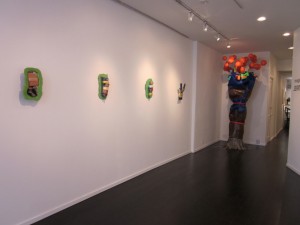
In the front window, viewers see two head sculptures from Mischak’s latest body of work.
The huge scale of the heads in comparison to the bases give the heads a weightless appearance similar to hot air balloons. The crisscrossing duct tape skin gives the sculptures a lot of texture and conjures up images of mummies. The way the duct tape follows the form in different directions makes the viewer’s eyes move around the sculpture. The exaggerated forms of these heads remind me of theatrical costumes and cartoon characters. They are made with serious thought and attention to detail, but are also humorous.
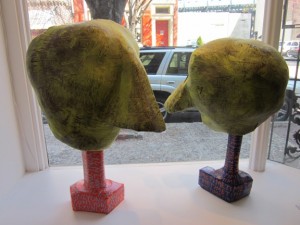
The surfaces and coloring of these heads are different from the mostly smooth surfaces of the other sculptures in this exhibition. On the heads, the outer layer of duct tape is painted brown with a thin layer of light green on top. It’s like a strange, unnatural patina. The bases of these sculptures are covered in text. One base is neon orange with the word “Only” written in blue paint all over it. The other base is dark blue with the word “Time” written in orange paint.
Be sure to also see Stephanie Craig’s solo exhibition of ceramics and drawings in the downstairs gallery. Her technical skill and ability to create emotive, rich work is incredible. Her Factory Work Series addresses outdated methods and ideologies that are still used today when it comes to labor and productivity.
Imaginary Solutions and Factory Work run to May 3.


